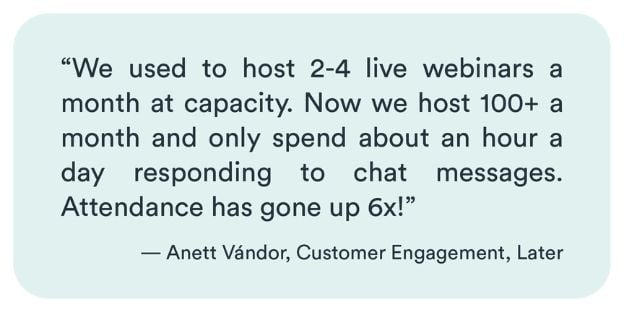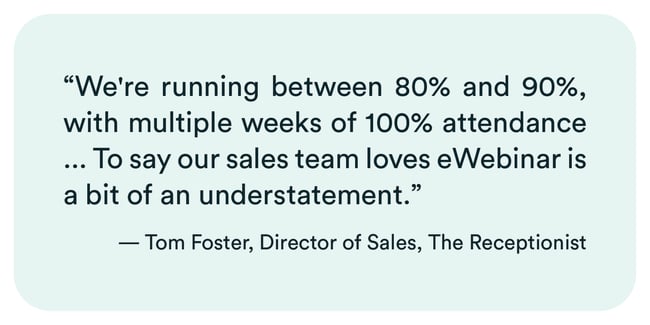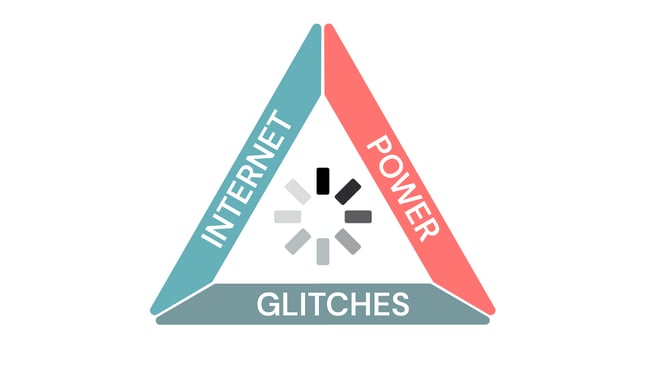The right webinar strategy can help you get more attendees, higher conversion rates, and more ROI out of every presentation. However, you'll only be able to reap these benefits if you get each step of the process right.
This guide will walk you through the 7 factors to consider when creating a successful webinar strategy:
-
Setting the right goals
-
Your target audience
-
Promoting your webinar
-
Increasing attendance
-
Engaging attendees
-
Maximizing conversions
-
Post-webinar follow-up
We'll also include a bonus section at the end of this guide that focuses on the significant benefits of automating your webinars — which is what our product, eWebinar, was specifically built for.
Throughout the post, we give examples from our product that demonstrate how to implement the suggested strategies but rest assured that the same approach can be adapted to whatever software you use. If any features are unique to us, we'll let you know.
Let's dive in!
1. Setting the right goals
Before you can start building a robust webinar marketing strategy, you first need to figure out what you're actually trying to accomplish by hosting webinars. Webinar speakers aiming for lead generation will choose a different webinar topic than those who are just trying to build a following, for example.
Webinar goals could include:
-
Building your brand
-
Nurturing leads
-
Driving sales
While webinars can often progress multiple business goals simultaneously, you should really only focus on one primary goal to get the best results. This ensures that the highest-impact objective will come first.
You’ll also need to choose the right metric(s) to track progress towards your goal. Common key performance indicators (KPIs) include trial signups, booked calls, or revenue generated. These metrics are more actionable because they measure the actual impact on your business.
Once you have your webinar objectives clearly laid out, it's time to move on to the next step.
2. Identifying your target audience
Now that you know why you're running webinars, it's time to find out who you're running them for. Creating buyer personas is an effective way to determine who your target audience is and which problems they're trying to solve.
Tip: If you have existing customers, you could conduct surveys and interviews to craft more accurate buyer personas based on the real people who are already giving you money.
Identifying your target audience will also be critical when creating a high-converting webinar landing page. The more familiar you are with your audience, the easier it will be to write messaging that compels them to sign up for (and attend) your webinar.
Specifically, there are four questions that your webinar registration page needs to answer before a visitor will turn into a registrant:
-
Is this for me?
-
Who’s behind this training?
-
Can I trust what they’re teaching?
-
When can I watch?
Agitating their pain points and establishing expertise will take care of the first three.
Getting past the fourth and final question comes down to making it as convenient as possible for people to attend your webinar. We'll dive deeper into scheduling best practices toward the end of this guide but the key takeaway is that more scheduling options = higher attendance rates.
This is evidenced by the customers who use our automated webinar software to run more sessions:
3. Promoting your webinar
Whether it's through social media channels, paid advertising, or organic search, you'll need a means of getting traffic and turning landing page visitors into webinar registrants. Each method of generating signups has its own set of pros and cons.
Organic social media posts may be cheaper than paid ads but they'll also take longer to gain traction. As such, you'll want to factor in your webinar launch date and find the most cost-effective promotion method that still gets you there in time.
The way you promote your webinar and structure marketing campaigns will ultimately depend on who you're targeting as well as what you're trying to achieve — which is why promoting your webinar is the third step in this guide.
Marketing efforts for promoting your webinar usually fall into one of four categories:
-
Content marketing
-
Email marketing
-
Organic social
-
Paid ads
The steps required to set up each of these channels are outside the scope of this article but you can learn more by reading our full webinar promotion strategy guide on 25 Ways to Promote An On-Demand Evergreen Webinar. That said, the golden rule is to only focus on one channel when you're starting out.
Once you've mastered one channel and doubled down on it, only then should you entertain expansion.
"One channel, one product, one avatar." ~Alex Hormozi
4. Increasing attendance
The final step of webinar planning is to ensure that people actually show up for the upcoming event. All your effort to this point will be nullified if those who heard about your webinar (and maybe even signed up) don't follow through on attending the presentation.
First and foremost, you'll want to have a sequence of reminder emails ready to go.
Reminder email subject lines should contain three key elements:
-
Webinar title
-
Webinar date
-
Attendee name
This ensures that the recipient knows which webinar you're contacting about, when it's scheduled for, and who the email is addressed to — all without even needing to open the message. As for the content itself, there are a few things you can say in the email that will compel registrants to follow through.
Reiterating all the benefits that your webinar landing page promised is the most reliable approach since it reminds them of the reasons why they signed up in the first place. Agitating the same pain points will once again light the fire that drove them to their original commitment.
You could also offer limited incentives to encourage attendees to show up and arrive on time.
Giving a free eBook to the first 10 people to join the presentation or offering free audits to anyone who arrives within five minutes of the webinar starting will increase the value add. This may not be enough to completely change people's minds but it can serve as a nudge for those who were on the fence about attending.
To learn more, read our full guide on How to Increase Webinar Attendance Rates!
Last but not least, the most reliable way to turn registrants into actual webinar attendees is to make your sessions as convenient to attend as possible. Once again, we'll go over this tactic in-depth in the final section of this guide but let's move on to the next step for now.
5. Engaging attendees
Getting people to attend your webinar is only half the battle.
Engagement and conversion are the next obstacles you need to overcome to get an ROI on your webinar.
There are two main mechanisms for engaging attendees during a webinar presentation:
-
Chat. Having live chat enables two-way communication between the webinar host and their attendees. Not all webinar platforms give you the ability to respond to chat messages after the presentation ends while others use a fake "simulated chat" that sends real messages into the void.
-
Interactions. Interactions include things like polls, quizzes, contact forms, and CTA popups. The exact interactions available will vary between each webinar platform but most software have at least a few options to choose from.
Here's an example of the 20+ interactions that our product, eWebinar, equips webinar hosts with:
Not only do these interactions keep attendees engaged but the responses to them can also yield valuable audience insights. These insights include everything from feedback you can use to improve your product/service/webinar to registrant data for your CRM.
Tip: Registrant data can be used to automate your post-webinar follow-up sequences with webinar integrations like ConvertKit, HubSpot, or Zapier.
While most webinar tools only have a handful of interactions, you should still work with what you have and start incorporating the interactive elements that are available to you. To learn more, read our full guide on How to Make a Webinar Interactive!
6. Maximizing conversions
An interactive webinar program will lead to higher audience engagement and longer watch times but that doesn't guarantee that your attendees will turn into customers. Conversion rate optimization (CRO) for webinars is different from the tweaks you'd make for landing pages or paid ads.
If a webinar isn't converting at all, your offer simply isn't aligned with what attendees want.
However, a webinar that's converting poorly is falling short on one or both of the elements below:
-
Presentation structure. The way you structure your webinar will determine how long attendees stay and how ready they are to convert by the end.
-
Call to action (CTA). Your CTA is the main ask. However, even the best CTA will only be effective if attendees stay long enough and are primed for conversion by the time they hear it.
Both are important and one can't perform without the other.
A great CTA is worthless if the presentation structure bores your attendees or makes them leave before hearing it. A great presentation is worthless if the CTA is so uncompelling that attendees don't convert even after attending the entire webinar.
Let's start with presentation structure.
Instead of reinventing the wheel, the smarter approach is to use a proven presentation structure that has already yielded good results for others. A prime example would be our five-stage on-demand demo structure:
-
Agenda. A 30-second overview of who you are and what you'll cover during the presentation will put your attendees at ease while putting them in a listening-oriented mindset.
-
Backstory. Explain the problem you've experienced and how your product or service solved it. This will agitate their pain points, tease the solution, and build your firsthand credibility.
-
Competition. Introduce the “villain” of the story (which is the status quo). This is when you explain the specifics of the problem and how other solutions fall short when trying to solve it.
-
Solution. Once your audience understands the problem and trusts you, it’s time to reveal the “hero” of the story — your solution. Go over 3-4 features/benefits that your customers talk about.
-
CTA. Ask for the close by clearly stating the next step attendees should take. If you want to give attendees more time to think about the offer, you could add a CTA banner above the webinar that allows them to convert early whenever they’re ready to move forward.
You can read our full guide on How to Craft High-Converting Webinar CTAs to learn more.
To save you time, the key takeaways there are that you should spend roughly 80% of the time providing value rather than pitching, your webinar should only have one CTA, and it should be the same CTA that you follow up with after the presentation ends.
Speaking of follow-ups...
7. Post-webinar follow-up
What you do after your webinar is just as important as the presentation itself. Not everyone will be ready to convert by the end of your webinar (especially if you're selling high-ticket offers). As such, having your sales team reach out afterward can get attendees who are on the fence to convert.
Even if they don't convert right away, your outreach efforts could get them to join your mailing list or sign up for future webinars. These lead captures serve as a safety net so you don't lose the lead entirely but instead get another opportunity to convert them into a customer down the road.
The first thing you'll need to do is segment your follow-up email sequences into three categories:
-
Those who didn't attend. Tell them what they missed out on and provide a replay link so they have another opportunity to watch the presentation.
-
Those who left early. Remind them of the reasons they signed up, highlight key talking points from later in the presentation, and give them the call to action that they didn't hear the first time.
-
Those who finished. Provide a summary of the talking points/benefits, address any remaining objections, and then do what you can to close the deal (or at least capture the lead).
Segmentation makes it possible to send out personalized emails that resonate with the recipient.
If your emails make assumptions about how far into your presentation an attendee got then it runs the risk of referencing content that the recipient isn't familiar with. Similarly, assuming your recipient knows nothing means you'll be repeating the same things that those who watched your webinar already heard.
Beyond the content itself, you'll also want to tailor the subject lines based on how far they've watched.
Here are some subject lines examples you can use:
-
Didn't attend: Sorry you missed the webinar, { first name } — Watch a replay now
-
Left early: Sorry you had to go, { first name } — here’s a recap of { webinar title }
-
Finished: { first name }, here are the bonus materials from { webinar title }
To learn more, read this guide on How to Write Webinar Follow-Up Emails That Get Results!
Bonus: Automated scalability
All the steps above will help you run a successful webinar once and achieve a one-off return on your investment. However, it's actually possible to host recurring webinars that continue to drive conversions on autopilot — all without putting in too much extra effort.
How?
Webinar automation.
Automated webinars — which you can create using pre-recorded videos — help you scale the business impact of your presentation and turn it into a flywheel that keeps on giving. In addition to saving you time, automated webinars provide three core benefits:
-
Scalability. You can host monthly, weekly, or possibly even daily webinars — but can you host multiple presentations every single day? Not without automating.
-
Attendance. Because automated webinars can run 24/7, registrants have more options for when to join. As we alluded to earlier, more scheduling options lead to higher attendance rates.
-
Consistency. Automated webinars play the same presentation each time an attendee lands which leads to higher quality, lower costs, and the elimination of unexpected technical difficulties.
We'll take a quick look at each of these benefits in the sections below!
Benefit #1: Scalability
Automated webinars let you maximize your reach by hosting hundreds of webinars per month across every time zone. In fact, eWebinar even has a dynamic time zone feature that you can use to adapt scheduling based on where the attendee is located.

Webinars that you give over and over again are the perfect candidates for automation:
-
Training
-
Sales demos
-
Customer onboarding
Benefit #2: Attendance
It's not just a matter of volume (session volume) but also efficiency (attendance rates).
Automated webinars make it more convenient for registrants to attend by giving them more options. This is the reason why our customers get average attendance rates of 65% — with some getting upwards of 90%!

There are three scheduling types you can choose from when creating automated webinars on eWebinar:
-
On-demand webinars. On-demand sessions let attendees join the presentation instantly. You can also toggle on "just-in-time" sessions so that your automated webinars are scheduled to begin within a few minutes of a visitor landing on your page.
-
Recurring webinars. Scheduling recurring webinars at set times will help you capture leads who aren't ready to watch your presentation right this moment. Like we mentioned above, these sessions can adapt their schedule based on whatever time zone the attendee is in.
-
Webinar replays. Webinar replays — which still have the same live chat capabilities and 20+ interactions — let your attendees pause, play, or skip around parts of the presentation like they'd do with a YouTube video.
Automated webinars attract an audience by being more convenient to attend.
In contrast, live webinars are at the mercy of your attendees' busy schedules.
Benefit #3: Consistency
Lastly, automated webinars use the same presentation recording over and over again. This means that every single attendee will have a smooth webinar experience and be more likely to convert at the end. By comparison, live webinars are susceptible to the Triangle of Technical Difficulties:
If any one of the three elements above fails on the host's end, the live webinar will grind to a screeching halt. Automating your webinars gives you the luxury of eliminating yourself as the single point of failure so you're still able to convert attendees even if your power or internet cuts out.
Reusing the same recording also lets you provide a higher-quality presentation to each attendee:

If you'd like to experience an automated webinar firsthand then join our quick on-demand demo:


Conclusion
Even a killer webinar marketing strategy will fall flat if you don't have the right approach to executing it.
Too many people fall into the trap of creating a great webinar but only using it once. What you really need is a recurring presentation that can generate consistent results weeks, months, or even years after your upcoming webinar launch day.
That's the only webinar strategy that will help you generate leads and sales on autopilot.
If you want to experience an automated webinar for yourself then watch our on-demand demo below:


(Yes, we actually use our product to demo our product.)








